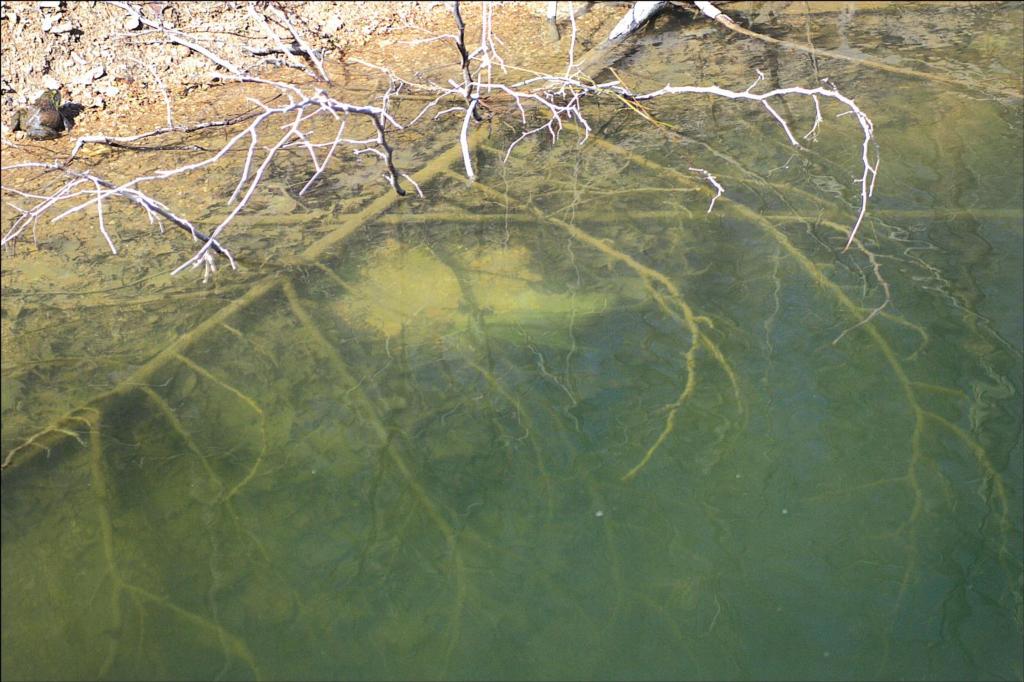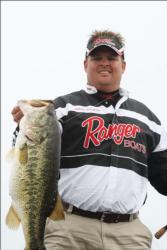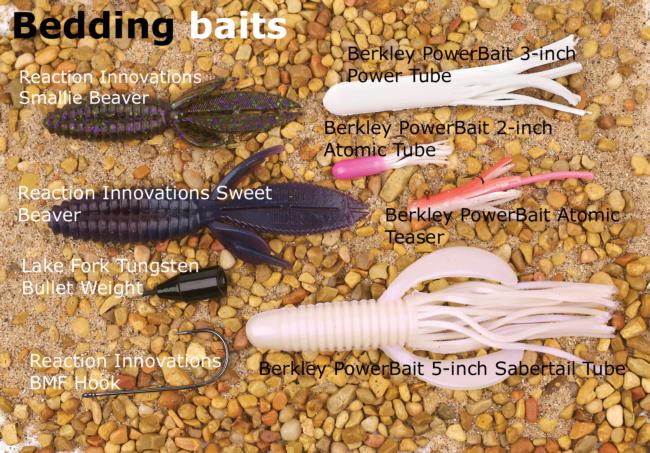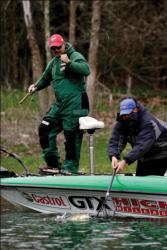A bed-fishing primer
Seeking largemouths during the spawn

————————————–
Editor’s note: This article originally appeared in the April 2008 issue of FLW Outdoors Magazine.
————————————–
Another spring is upon us. Tournaments are raging full-swing, the shallows are warming up, and the trees are budding. To avid largemouth fishermen, particularly in temperate Southern climes, this time of year means one thing – sight-fishing.
At one time, the practice of fishing for bass defending nests was viewed in an unfavorable manner by many. To some, it still is, and in some states, particularly Northern states where smallmouth bass make up the bulk of the catch, the practice is avoided via closed seasons. But many anglers have realized that with strong catch-and-release ethics, sight-fishing for largemouths can produce many things with few ill consequences. For starters, watching how a bass interacts with a lure and practicing stealthy approaches to beds can dramatically improve all facets of fishing away from sight-fishing.
There’s much more to catching a largemouth bass off a bed than simply spotting it and tossing a tube in front of it, however. The best sight-fishermen are masters of the technique, which is different than virtually any other type of bass fishing. The main difference, of course, is that they’re not trying to make fish hungry. They’re trying to tick them off.
Finding beds
Before an angler can plunk a big, bright bait into a sow largemouth’s bed and harass her to the point of mugging it, he or she must find that bed. In a tournament scenario, power-fishermen prevail when it comes to pure bed-fishing efficiency, and when it comes to power-fishing, few are as adept as anglers from Texas.
James Stricklin Jr. of Jasper, Texas, is a regular competitor in the Stren Series Texas Division. Stricklin holds the honor of having caught one of the largest single-day stringers in FLW Outdoors history at Lake Amistad in the winter of 2007. But as good as he is at prespawn fishing, the pro excels when it comes to sight-fishing.
Save for his crappie and bluegill rods, it’s not clear if he owns any spinning tackle, either. He’s a professed power-fisherman, and when a tournament is projected to be won by sight-fishing, he knows covering water in practice to find beds is the name of the game. Texas lakes are numerous and often large, however, so Stricklin, originally from Arkansas, has to rely on maps and basic knowledge of bedding fish to narrow his search on new lakes prior to tournaments.
“When scouting for beds, the first and foremost things you need to look at are the north bays of the lake,” he said. “The bays in the north side get the most sunlight during the day, so they’re the first ones to warm up. South winds blow warm water to them as well. By the same token, cold wind keeps the south bays cooler, and they’re usually not ready until the second wave of spawning fish arrives.
 “Another thing about the north end of the lake in general is that it’s typically clearer than the south end. This makes it warm up faster, but it won’t retain heat like the south end. Particles and things in the water stain it and keep it warmer overnight. This makes north bays in midlake areas great places to begin your search.”
“Another thing about the north end of the lake in general is that it’s typically clearer than the south end. This makes it warm up faster, but it won’t retain heat like the south end. Particles and things in the water stain it and keep it warmer overnight. This makes north bays in midlake areas great places to begin your search.”
Even from there, northern bays in a big lake can cover a pretty large area. One bay can take more than an hour to scout if one covers every inch. But Stricklin begins his search in the back of the bay near any feeder creeks and works his way out, keeping his trolling motor on high and resisting the temptation to pick up a rod and fish as he goes along. Years of practice have taught him what to look for – namely white, contrasting, bowl-shaped areas on the bottom.
“I keep my boat in the deepest water possible while still being able to see bottom,” Stricklin said. “Bigger fish are usually bedding as deep as you can possibly see.”
Even on obvious beds, those that are cleared of debris and appear as plainly as a massive white cereal bowl on the bottom of the lake, bass can be difficult to see. Often, a fish will hover over the middle of the bed, but just as often, it’ll lurk in the shadows just outside. When spotting key features of the fish such as a pointy nose, dark lateral line or flash of a tail, this becomes important.
“I had found one bed in 5 feet of water on Toledo Bend during a tournament several years ago,” Stricklin said. “The water was stained, and I couldn’t really see the bed. I saw what looked like a log laying there under the water. I ended up catching that fish in three casts. If I hadn’t known what to look for, I wouldn’t have caught that fish.”
Learning what to look for is simply a matter of practice. The fish that are easiest to catch off a bed are also often the hardest to see, because they’re “locked on,” or defending a nest so diligently they don’t shy away from a boat passing through. Stricklin likes amber-tinted polarized lenses for spotting beds, particularly on cloudier days.
“If you see a shadow near or in a bed in 5 or 6 feet of water, you need to stop and see if it moves,” Stricklin said. “You really want to find fish that are locked on tight. You don’t want to waste your time with cruisers or finicky fish.”
Judging the size of these deep fish, particularly when moving through at high speeds, can be tricky. Stricklin has a few tricks of his own, however.
“Overall, the biggest key in judging size is first knowing how deep they are,” he said. “If it’s 4, 5, 6 or more feet of water, and you think it’s a 3- or 4-pounder, it’s likely a 5- or 6-(pounder). You can usually add a pound or 2 if they’re down deep.”
Picking a bed bait
Andre Moore of Alabaster, Ala., knows a thing or two about choosing baits for sight-fishing. The pro has won the FLW Tour’s Walmart Open on Beaver Lake twice – a spring tournament with a famed sight-fishing bite. He’s also owner of Reaction Innovations baits – lures famous for pure effectiveness. Moore’s signature lure, the Sweet Beaver, and its little brother, the Smallie Beaver, are among the most popular sight-fishing baits out there. They’re soft plastics that don’t look like any one creature in particular (unless you’ve seen “Star Trek: The Wrath of Kahn”, and remember those nasty bugs that crawled into people’s ears), but they both definitely look like something that’s alive and could possibly make a meal of a pile of bass eggs. That’s really all that matters to bedding fish.

“Before I knew any better, I thought the realistic baits made a big difference,” Moore said. “But ever since I created the Beaver and the Smallie Beaver, there are only two or three other baits I’ll even throw at a bedding fish.
“The thing about catching those fish (more so than the shape of the bait) is that when you go to some of these lakes, you have to figure out what each fish is protecting its nest from. What part of the water column is it defending? Where are the critters trying to eat their eggs coming from? Sometimes, they’ll only look at something that’s suspended, while at other times, they only bite things hopped in the nest. It’s more figuring out a fish’s temperament and what ticks it off than anything.”
Beyond his Beaver baits, which really fall into the creature-bait category, Moore often uses tubes for sight-fishing. Large tubes, particularly brightly colored ones like white and pink, are classic bed baits.
“Tubes fall a little faster,” Moore said. “If you need something they will react to, a tube is a good bait.”
Moore will often scale the size of his tube down, even to a crappie tube on a jighead, if fish are behaving reluctantly.
“A magnum-sized crappie tube stuffed with a little jighead is about 1 1/2 inches long,” Moore said. “You can twitch that thing, and it will dart all around. Sometimes, when you have fish that won’t hit anything, they’ll hit that.”
The bright colors not only tend to agitate fish a little more, they’re easy for the angler to see. Bass on a bed will usually give an angler only a fraction of a second to set the hook before spitting a bait. Oftentimes, the strike is impossible to feel, so a brightly colored lure gives a visual cue. Of course, in a bed with a sandy bottom, going with something that contrasts, particularly black, does the same thing. Moore tends to keep one of both rigged on his deck, and he tries them both throughout the day. Typically, one or the other will stand out as the clear choice to the fish.
Some pros prefer a Texas rig for sight-fishing, while others try to stick with jigheads. Moore sees applications for both but likes a jighead when he can get away with it.
“In a lot of the clear lakes especially, I like a jighead with an exposed hook,” he said. “A lot of times they’ll be biting funny, or it will be windy and I can’t see them. If I feel weight, I can pull-set them. If I pull on the rod and it’s in his mouth, he’s hooked. He’d spit a Texas rig if you tried that.
“A lot of guys will snag more fish with a Texas rig because they think they have a fish and jerk too early,” Moore said. “But I don’t think I’ve ever snagged a fish with a jighead. An exposed hook definitely helps when you can get away with it. Of course, on a grassy bank, a Texas rig is the only way to go.”
Overall, reading individual fish and their preferences is more important than a key style of bait. Moore fondly remembered a 3-pounder that had garnered somewhat of a reputation as an impossible bed fish at a Lake Havasu tournament several seasons ago. Moore and others had tried to catch the fish with standard sight-fishing gear and failed.
“I had a 16-inch swimbait that I had hand-poured myself,” he said. “I had made it in a carp color, and fish on Havasu were really working hard to keep carp away from their nests. I knew that bait was nearly as big as the fish, but I threw it out, and that sucker ate it on the first cast. So it really just depends on the mood of each individual fish (when it comes to bait choice). A big bait will usually make a big fish more protective, but I try to stay with a high-percentage hookup bait most of the time before I start throwing the funky stuff around.”
Darrel Robertson of Jay, Okla., should never be ignored when it comes to catching visible bass on beds. The salty veteran of the FLW Tour, with more than $1.5 million worth of career earnings to his credit tends to be a contender in springtime sight-fishing tournaments.
Many sight-fishermen have many different “styles,” so to speak, when it comes to actually tempting a bedded largemouth into biting. Robertson is no different. For him, catching a bass off the bed usually begins with a single blind-cast.
“I never stop and fish for a bass when I first see it on the bed,” Robertson advised. “I’ll pass on by it and fish 50 yards or so down the bank before turning around and throwing a distant cast with a little finesse worm. More than half of the bedding bass I catch are caught like that on the first cast. But if I don’t catch him like that and determine that he’s locked on, I’ll move in to where I can see him.”
Pros have various tricks up their sleeves for agitating the strike. Some, like Stricklin, like to have a very slight amount of slack line out to hop a bait up and down repeatedly in the bed. Robertson simply likes to move the bait through the bed quickly and repeatedly.
“I don’t switch around to a lot of different baits,” he said. “What’s more productive is to get him excited and keep him excited until he bites. If he’s really locked on, eventually he’ll bite.”
There are ways to speed up the process, however. Skilled sight-fishermen have mastered the art of reading fish. Many of them can even “call” the cast that’s going to produce a bite. There are certain things a defending largemouth will do that can cue anglers in to impending pandemonium. Among them are flaring gills and quick, aggressive turns and spins over the nest near the bait. If a bass begins doing this, it’s a good bet it’s going to bite.
Many pros will actually try to bump the bass with the lure during the tempting process. While this may spook a less-committed fish, it will drive one that’s really sitting tight into fits of rage.
“The dorsal fin is what you really need to touch with your line when you’re trying to run your bait into them,” Robertson said. “That fish may start out docile, or even swim off, but if you’re hitting it with the line and bait and it starts making quick turns in the bed, it’s going to bite.”
When a fish starts making quick turns, it’s especially important to be back in the bed with the next cast. In fact, if that cast is messed up, the fish may calm down, and to get it to bite may require going through the whole process all over again.
“You like for them all to bite in five or 10 minutes,” he continued. “But that’s not always the case. But if a fish will stay on a bed, it will bite.”
With such knowledge in his head, it’s difficult to convince Robertson to leave a fish on the bed, but a few things will prompt him to take his search elsewhere. Big bass often bed around pieces of cover, such as treetops and stumps, and these can get in the way at times, making catching the fish difficult or impossible.
“Mainly, if I leave a bed, it will be because a piece of structure won’t allow me to get the bait to the fish,” Robertson said. “You may get the fish aggravated, but he’ll move, and then you can’t get to him. I have moved stuff like that and come back to those beds later, however.”
Bigheads are special
Overall, most pros who’ve fished for all three species consider largemouths the most difficult bass to catch off the bed. They tend to be warier and less aggressive, and the fact that sight-fishing is becoming more and more popular on many largemouth lakes means more fishing pressure. There are fewer opportunities to sight-fish for smallmouths, and they’re often more aggressive by nature anyhow. But that is another topic for another day.
